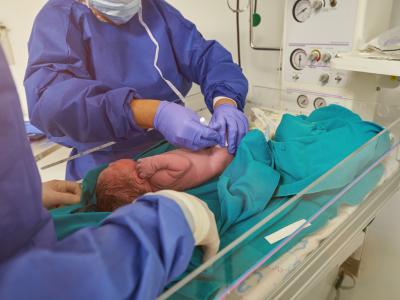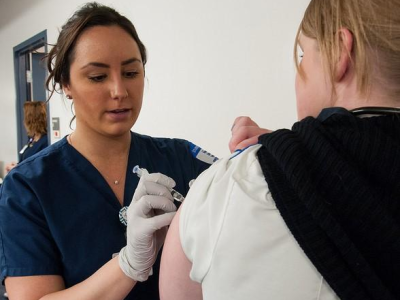Our weekly wrap-up of antimicrobial stewardship & antimicrobial resistance scans
Phase 3 trial shows safety, high efficacy of typhoid conjugate vaccine
A phase 3 clinical trial conducted in Malawi has found that a single dose of typhoid conjugate vaccine (TCV) is safe and more than 80% effective at protecting children against typhoid fever, an international team of researchers reported yesterday in the New England Journal of Medicine.
In the randomized, double-blind trial, investigators assigned children from 9 months to 12 years of age in a 1:1 ratio to receive a single dose of Vi polysaccharide typhoid conjugate vaccine (Vi-TCV) or meningococcal capsular group A conjugate (MenA) vaccine as the control group. The primary outcome was typhoid fever by confirmed blood culture. Vaccine efficacy and safety outcomes were reported after 18 to 24 months of follow-up.
A total of 28,130 children were included in the intention-to-treat analysis, with 14,069 assigned to Vi-TCV and 14,061 to MenA. Blood culture-confirmed typhoid fever occurred in 12 children in the Vi-TCV arm (46.9 cases per 100,000 children) and in 62 children in the MenA arm (243.2 cases per 100,000). The protective efficacy against culture-confirmed typhoid fever at any time after vaccination was 80.7% (95% confidence interval [CI], 64.2% to 89.6%) in the intention-to-treat analysis and 83.7% (95% CI, 68.1% to 91.6%) in the per-protocol analysis. The efficacy was similar in children 5 years and younger and those 5 years and older.
In total, 130 serious adverse events occurred in the first 6 months after vaccination (52 in the Vi-TCV group and 78 in the MenA group), including 6 deaths, all in the MenA group. No serious adverse events were considered by the trial investigators to be related to vaccination.
The investigators say the findings are critical given that several multidrug-resistant strains of typhoid fever, which is caused by Salmonella enterica serovar Typhi, have emerged in Malawi and eastern and southern Africa, making treatment more challenging. They note that 100% of typhoid fever samples among the children in the trial were resistant to first-line antibiotics, and four SalmonellaTyphi strains showed reduced susceptibility to fluoroquinolones.
"Our only real option to controlling these new resistant strains of typhoid in a timely way is through the vaccine," lead investigator Melita Gordon, MD, of the University of Liverpool and the Malawi-Liverpool-Wellcome Trust Clinical Research Programme, said in a university press release.
Malawi will soon begin a mass rollout of the vaccine in children aged 9 months through 15 years.
Sep 16 N Engl J Med study
Sep 15 University of Liverpool press release
Multifaceted primary care stewardship tied to fewer prescribed antibiotics
A randomized trial conducted in Ontario found that a multifaceted antibiotic stewardship intervention implemented in primary care practices was associated with reduced likelihood of antibiotic prescriptions for urinary tract and respiratory infections, researchers reported this week in BMC Family Practice.
In the pragmatic trial, practitioners from six primary care clinics in Toronto were assigned to a control group or an intervention group to evaluate the effectiveness of the intervention, which involved clinician education, clinical decision aids for prescribing decisions, patient information leaflets, audit and feedback of clinic prescription practices, local clinic support, and incentives. The primary outcome was total antibiotic prescriptions for urinary tract and respiratory infections, and secondary outcomes included delayed prescriptions, prescriptions lasting longer than 7 days, and use of recommended antibiotic.
There were 1,682 encounters involving 54 primary care providers from January until May 31, 2019. After adjustment for characteristics associated with antibiotic prescription, the odds of any antibiotic prescription were reduced by 22% (adjusted odds ratio [OR], 0.78; 95% CI, 0.64 to 0.96) in intervention clinics compared with control clinics.
The odds that a delay in filling a prescription was recommended at an intervention clinic was increased (adjusted OR, 2.29; 95% CI, 1.37 to 3.83), while prescription durations greater than 7 days were reduced (adjusted OR, 0.24; 95% CI, 0.13 to 0.43). Recommended antibiotic use was similar in control (85.4%) and intervention clinics (91.8%).
"This study has demonstrated that clinically important changes in antibiotic utilization in primary care clinics are possible with local stewardship efforts involving provider-focused education, clinical decision aids, clinic support, ongoing audit and feedback, and compensation for [antimicrobial stewardship] activities," the study authors wrote. "Structured and supported community-based antimicrobial stewardship efforts, similar to those in hospital settings, warrant further study."
Sep 15 BMC Fam Pract study
CDC launches antibiotic stewardship toolkit for healthcare payers
Originally published by CIDRAP News Sep 16
The Centers for Disease Control and Prevention (CDC) yesterday launched a toolkit to help healthcare payers support appropriate antibiotic use in outpatient settings.
The toolkit, developed in collaboration with the Pew Charitable Trusts and healthcare stakeholders and based on the CDC's Core Elements of Outpatient Antibiotic Use, identifies the activities that healthcare payers can implement to support outpatient antibiotic stewardship in primary care clinics and urgent care centers. Those activities include tracking and reporting antibiotic use within insurance networks, communicating commitment to stewardship to network members, implementing patient education campaigns, ensuring clinicians have access to current clinical guidelines, and conducting audit-and-feedback interventions for high-prescribing clinicians.
The CDC says healthcare payers—which include private health plans and Medicare and Medicaid—can play an important role in improving outpatient antibiotic use, because they have financial oversight in the provision of healthcare and are uniquely positioned to facilitate quality improvement measures.
Among the examples provided in the toolkit is an audit-and-feedback intervention conducted by Aetna over a 3-year period to target network clinicians who prescribed antibiotics to more than 50% of outpatients diagnosed as having acute bronchitis. The company sent more than 4,500 letters to clinicians from 2016 to 2019 and observed a 6% improvement in antibiotic prescribing for bronchitis over that period.
"All antibiotic use contributes to resistance, and most antibiotics in the US are given in outpatient settings—many of them inappropriately," David Hyun, MD, director of the Pew Charitable Trusts' antibiotic resistance project, said in a statement emailed to reporters. "Insurance companies can give providers the information they need to improve antibiotic stewardship, and the new toolkit from CDC gives them a roadmap."
Sep 15 CDC toolkit for healthcare payers
Transatlantic AMR task force lays out new 5-year plan
Originally published by CIDRAP News Sep 16
The Transatlantic Task Force on Antimicrobial Resistance (TATFAR) yesterday released a draft work plan identifying actions for continued collaboration over the next 5 years.
The plan is broken down into four key areas: appropriate antimicrobial use in human and veterinary medicine; surveillance and prevention of AMR; strategies to improve financial, access, research, and development of new antimicrobials, diagnostics, and alternative therapies; and actions to improve dissemination of information. The identified actions include consultation and regular exchanges of information among the TATFAR countries on actions that could help advance progress in those four key areas.
TATFAR was established in 2009 to bring together agencies and technical experts from the United States, Canada, the European Union, Norway, and the United Kingdom to collaborate and share best practices to strengthen domestic and global practices on appropriate antimicrobial use, prevention of healthcare-associated infections, and strategies for improving the pipeline of new antimicrobial drugs.
Sep 15 TATFAR draft work plan
NDM-producing Enterobacterales levels rising in Switzerland
Originally published by CIDRAP News Sep 15
Researchers in Switzerland have identified an increase in New Delhi metallo-beta-lactamase (NDM)–producing Enterobacterales, according to a report published today in Emerging Infectious Diseases.
Of the 532 carbapenemase-producing Enterobacterales (CPE) samples obtained from Swiss hospitals and clinics in 2019 and 2020, 141 were confirmed to be NDM-positive—accounting for more than 25% of all CPE submitted to the Swiss National Reference Center for Emerging Antibiotic Resistance (NARA). NDM enzymes are capable of conferring resistance to nearly all beta-lactam antibiotics, including carbapenems, and treatment options for infections caused by NDM-producing Enterobacterales are limited, as they frequently harbor additional resistance genes.
Most of the NDM-positive isolates were either Klebsiella pneumoniae (59 of 141) or Escherichia coli (52 of 141), and more than 50% were obtained from screening swab samples. Among the 108 isolates that were sequenced, NDM-1 was the most prevalent, occurring in 56 isolates, mostly K pneumoniae (34 of 56). NDM-5 was the next most common, occurring in 40 of 49 E coli isolates, and other variants included NDM-4 and NDM-7. Fourteen of the isolates co-produced a second carbapenemase, predominantly an OXA-48-like enzyme, and almost one third of the isolates produced a 16S rRNSA methylase conferring high-level resistance to aminoglycosides.
Further molecular analysis found that the E coli and K pneumoniae isolates harbored multiple plasmids and belonged to sequence types and clonal complexes that have been identified in hospital outbreaks in other parts of the world. The authors of the study suggest these successful lineages are likely responsible for the observed increase in NDM-producing Enterobacterales.
"This 2-year study gives a snapshot of the epidemiology of NDM producers in Switzerland and illustrates how the use of [whole-genome sequencing] is both an essential and informative tool for surveillance and for monitoring emerging resistance," the study authors write. "Our findings underpin the importance of the surveillance of NDM-producing bacteria and particularly the monitoring of successful clonal lineages and plasmids."
Sep 15 Emerg Infect Dis study
Review finds elevated rates of antibiotic resistance in aquatic animals
Originally published by CIDRAP News Sep 14
A review and meta-analysis of point-prevalence surveys conducted in Asia over the past two decades found concerning levels of resistance to first-line and last-resort antibiotics in foodborne pathogens isolated from aquatic animals, researchers reported late last week in Nature Communications.
The systematic review identified 749 point-prevalence surveys reporting antimicrobial resistance (AMR) in aquatic food animals (fish and shrimp) in Asia published from 2000 to 2019, a period that saw substantial growth in aquaculture. From 2000 to 2018, the percentage of antimicrobial compounds with resistance exceeding 50% (P50) in each survey plateaued at 33% in cultured aquatic animals and declined from 52% to 22% in wild-caught aquatic animals. The study authors suggest the decline in wild-caught aquatic animals could be associated with reduced exposure to human and livestock fecal pollution.
Among the foodborne pathogens isolated (E coli, Vibrio spp, Aeromonas spp, and Streptococcus spp), resistance was highest to penicillins (60.4%), macrolides (34.2%), sulfonamides (32.9%), and tetracyclines (21.5%). In Vibrio and Aeromonas species, resistance to colistin was 42.7% and 51.5%, respectively; carbapenem resistance in Vibrio climbed from 5.1% before 2010 to 51.1% after 2010.
Predicted hot spots of multidrug resistance in freshwater environments, based on geospatial modeling, included eastern Turkey, southern India, the Yangtze River in China, and the lower reaches of the Mekong River and its delta in southern Cambodia and Vietnam. In marine environments, the highest rates of AMR were identified in northeastern China on the Yellow and East China seas; southern China and Central Vietnam on the South China Sea; southern India on the Arabian Sea and the Bay of Bengal between southern India and northern Sri Lanka; and the eastern Mediterranean Sea on the coast of Lebanon.
"This study identified elevated rates of antimicrobial resistance in bacteria isolated from aquatic animals intended for human consumption in Asia," the authors wrote. "A growing aquatic food animal production industry may serve as an important pathway for transmission of resistance along the food chain with potential consequences for human health."
The authors say their findings could help direct the prioritization of future surveillance efforts and inform planning for the sustainable development of the aquaculture industry.
Sep 10 Nat Commun study













